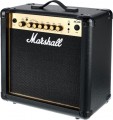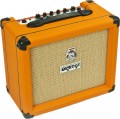Power
Rated power of the device.
Let us recall that in acoustics the rated power is the highest average (root mean square) power of a sound or signal that a device can produce for an indefinitely long time. Individual volume jumps can be several times higher than this indicator, but the key characteristic is the average value. But the specific meaning of this parameter depends on the type of equipment (see above). So, for combo amplifiers, this paragraph usually gives the power of the built-in speakers; The capabilities of your own amplifier, by definition, correspond to this figure, so for such equipment the rated power determines solely the overall sound volume. The power of the acoustics is also indicated for cabinets, but here another point becomes relevant - compatibility with an external amplifier (primarily the “head”). The output power of this amplifier should not be higher than the rated power of the cabinet to avoid overloads; and ideally, these characteristics should match - this will allow you to use the speaker at full power without sound distortion.
For the head, accordingly, this paragraph provides the rated output power, which determines the ability of the amplifier to operate with a specific cabinet or other speakers. However, it is worth noting that the maximum possible power value is indicated as the nominal value for heads, which is not always achieved. Thus, many models provide several sound outputs - for passive acoustics with different...impedances (remember, standard impedance values are 2, 4, 8 and 16 Ohms); and the higher the impedance of the connected speaker, the lower the actual power will be. Other heads have the ability to limit the maximum power - for example, so that at the maximum level the device produces not 100 W, but 50 W or even 25 W. Sometimes these features are combined in one device.
In any case, when choosing according to this indicator, it is worth taking into account the features of the planned use of the equipment. For example, it hardly makes sense to purchase even a 40-watt “combination” for practicing at home - for these purposes 15 watts, or even less, will be quite enough. And if we are talking about a tube device, then in our example the maximum recommended power will be only 5 W - the specificity of tube circuits is such that with the same rated power they are more effective than transistor ones in terms of audibility. For rehearsals in a group without a drum kit (for example, two guitars plus a bass), a higher power is desirable, about 40 “transistor” watts, and if there are drums, at least 60 watts. Transistor devices with a power of up to 150 W and tube devices with a power of up to 40 - 50 W are suitable for specialized rep bases and concerts in relatively small rooms, and higher figures are found mainly in equipment for large-scale events. Detailed recommendations regarding optimal power for certain conditions can be found in special sources.
It is worth mentioning bass amplifiers separately: it is believed that for normal coordination with each other, the power of a bass “combination” should be twice as high as the power of a guitar one.
Digital effects block
The presence of a block of digital effects in the amplifier. Note that this function can be provided in any models, not only digital ones (see "Type").
As the name implies, this function allows you to change the sound in one way or another, sometimes quite drastically. See below for the most popular effects; their specific set may be different, it should be specified separately in each model. Here we note that without this function, additional external “gadgets” will be required to work with effects.
Effects
Built-in effects provided in the combo amplifier. You can also achieve various effects with the help of external “gadgets”, however, such gadgets need to be searched for and connected separately, while built-in effects are available immediately and without unnecessary settings.
—
Overdrive. Distortion in the form of a characteristic electric guitar "buzz" at low frequencies and "howl" at high frequencies, a little softer than distortion. Popular, in particular, in hard rock.
—
Distortion. Sufficiently hard and sharp distortion, similar in sound to overdrive, but more intense and brighter. It is widely used in various styles of metal, and is also found in rock.
—
Reverb. An effect based on simulating multiple decaying echoes from each sound. Depending on the duration and intensity of repetitions, it can give the sound a different colour. Used as an artistic device; among other things, it can create the effect that the guitar sounds in a certain room (concert hall, room with stone walls, an open area in the mountains, etc.). Note that the reverberation can be adjusted both by individual parameters (intensity, echo duration, etc.), and by selecting a preset set of parameters (for example, “sharp sound in the room” or “soft sound in the hall”).
—
Tremolo. Tremolo is basically a trembling effect that res
...ults from small and quick fluctuations in the volume of each note. Sometimes this term means vibrato (see below) — to the point that the manufacturers of guitar amplifiers themselves mean the effect of vibrato by the tremolo effect, and vice versa. So the specifics of this effect in each case should be clarified separately. Anyway, the tremolo can be "fixed" or adjustable in depth (range of volume change) and speed (jitter frequency).
— Vibrato. Another effect of "jerking" sound, which is often confused with tremolo (see above) — to the point that both these terms are used as identical. However, this is not true; the difference lies in the fact that vibrato is carried out due to the rapid fluctuations of the note not in volume, but in frequency. A similar effect can be achieved on the guitar itself by "pulsating" the strings, but using the amplifier's built-in instrument is much more convenient in most cases.
— Chorus. An effect designed to simulate the choral sound of an instrument. To do this, the amplifier copies the sound of the guitar and plays several copies simultaneously with the original signal, slightly shifting them in time (about 20 – 30 ms with a constant change) and frequency. However it is impossible to achieve a full-fledged choral sound in this way, but the effect is quite original in itself.
— Delay. A specific type of reverb (see "Reverb") that has become widespread as a separate effect. Delay simulates a clear single echo from the sound being played; for this, the original signal is copied and reproduced with a certain time delay (at least 50 ms).
In addition to those described above, other effects can be found in modern guitar combo amplifiers, in particular:
— Flanger. The effect is reminiscent of the whistle of a jet engine; it is often compared to a plane taking off. It is created similarly to the Chorus described above, differs from it in a shorter delay time and the presence of feedback.
— echo. Another kind of reverb, similar to delay (see “Delay”). It differs in that in this case the echo is reproduced repeatedly.
— Octaver. An effect in which a copy of it is added to the signal, shifted by an octave or two.
— Wah wah. An effect that produces a characteristic "croak" sound.Footswitch
The number of connectors for
connecting pedals (footswitch), provided in the design of the amplifier.
The pedal is the most convenient way to quickly change amp settings and can be used while playing the guitar. The specific functions "tied" to the pedal connectors can be different: in particular, various effects can be turned on and off in this way (see above). Also, in different models, the number of connectors for pedals may vary: in most “amps” there is only one such connector, however, there are devices that allow connection of several “foot switches” at once.
Headphones
The type
of headphone output provided in the design of the amplifier.
Headphones will be useful especially in a situation where you can not make noise — for example, when practicing the guitar at a late time. And the options for their connection can be as follows:
— Mini-Jack (3.5 mm). Output for a standard 3.5 mm mini-Jack plug. This plug is equipped with most modern headphones, especially entry-level and mid-range. However, in terms of the quality and reliability of the connection, it is noticeably inferior to the larger Jack 6.35 mm (see below), so it is relatively rare in combo amplifiers.
— Jack (6.35 mm). The connector is quite large, designed mainly for stationary audio equipment. As the main connection method, it is rarely found among headphones, these are mainly professional models. At the same time, you can connect headphones with a 3.5 mm mini-Jack connector to such a jack using a simple adapter (in many “ears” such adapters are even included in the standard package); and the connection itself is tight, reliable and with a minimum of interference from the point of contact. Due to this, most "amps" use this type of connector.

